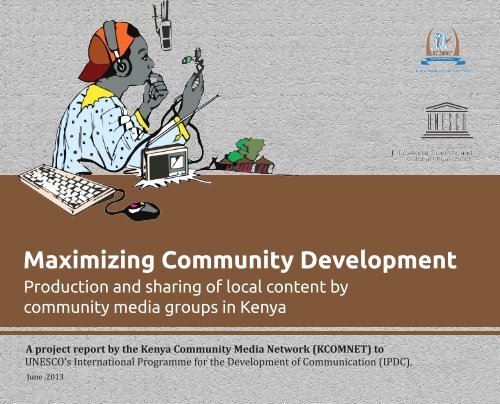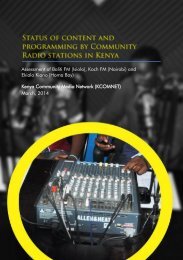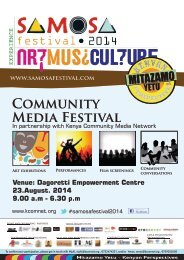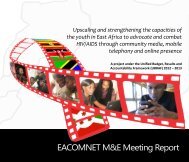Maximizing Community Development
This is a summary report of a project which was carried out by the Kenya Community Media Network (KCOMNET) on September 2012 – May 2013 through the financial support of International Programme for the Development of Communication (IPDC).
This is a summary report of a project which was carried out by the Kenya Community Media Network (KCOMNET) on September 2012 – May 2013 through the financial support of International Programme for the Development of Communication (IPDC).
Create successful ePaper yourself
Turn your PDF publications into a flip-book with our unique Google optimized e-Paper software.
<strong>Maximizing</strong> <strong>Community</strong> <strong>Development</strong><br />
Production and sharing of local content by<br />
community media groups in Kenya<br />
A project report by the Kenya <strong>Community</strong> Media Network (KCOMNET) to<br />
UNESCO’s International Programme for the <strong>Development</strong> of Communication (IPDC).<br />
June ,2013
<strong>Maximizing</strong> <strong>Community</strong> <strong>Development</strong><br />
Production and sharing of local content by<br />
community media groups in Kenya<br />
A project report by the Kenya <strong>Community</strong> Media Network (KCOMNET) to<br />
UNESCO’s International Programme for the <strong>Development</strong> of Communication (IPDC).<br />
Editor: Njuki Githethwa, KCOMNET<br />
Design and Layout: Amos Ochieng, KCOMNET<br />
Cover illustration: copyright PIWA/Tagor<br />
Photographs: Ezekiel Akwanah, KCOMNET<br />
June, 2013<br />
Contact Person:<br />
Njuki Githethwa, Coordinator, Kenya <strong>Community</strong> Media Network(KCOMNET)<br />
Shalom House, off Ngong Road, St. Daniel Comboni Rd, Wing C, 1st Floor<br />
P.O. Box 2641 - 00100, Nairobi; Tel: 254 0202379949; Cell: +254 722 474 221<br />
Email: njuki@kcomnet.org/njukig@yahoo.com<br />
Website: www.kcomnet.org<br />
Executive Summary<br />
This is a summary report of a project which was carried out by the Kenya<br />
<strong>Community</strong> Media Network (KCOMNET) on September 2012 – May 2013<br />
through the financial support of International Programme for the <strong>Development</strong><br />
of Communication (IPDC). The goal of the project was to enhance the capacity<br />
of community media in Kenya through the development and sharing of local<br />
content.<br />
Five community radio stations and community media groups from five counties<br />
were engaged in the project: The community radio stations are Radio Mang’elete<br />
in Makueni County, Mug’ambo FM in Meru County, Sauti – Hundhwe FM in Siaya<br />
County, Mwanedu FM in TaittaTaveta County and Koch FM in Nairobi County. The<br />
five community radio stations worked in collaboration with community theatre<br />
groups and artists to identify the issue of priority interest in their communities<br />
from which they developed and produced a series of drama shows which are<br />
being presented on air at the community radio stations, at community social<br />
centres and shared through KCOMNET and EACOMNET website and social<br />
media platforms.<br />
The presentation of the community drama shows is the climax of the project’s<br />
activities which commenced with a five days training and content development<br />
workshop which was held in Nairobi on October 22 – 26, 2012. The workshop<br />
was followed by on-site visits to the five locations served by the community<br />
radio stations to monitor, evaluate and mentor local processes on content<br />
sharing through community radio stations, community social centres and online<br />
platforms. The ensuing radio programmes have been shared at KCOMNET and<br />
EACOMNET websites and on social media platforms. A video documentary has<br />
been produced to share the lessons and experiences to a wider audience.<br />
This report will cover the following areas:<br />
1.0 Project Background<br />
2.0 Summaries of the main activities<br />
3.0 Achievements<br />
4.0 Next Steps<br />
5.0 Conclusion<br />
1<br />
1
1.0 Project Background<br />
<strong>Community</strong> Media continues to be an active participant in the pursuit of<br />
sustainable development of communities and the larger society. This is more<br />
so when community media sticks to its core mandate of reflecting and shaping<br />
content which is generated from the developmental aspirations of their target<br />
communities, be it a geographic or a community of interest.<br />
<strong>Community</strong> media is expressed in various art-forms that are located in<br />
grassroots communities. These art-forms include community theatre, paintings,<br />
music, puppetry shows, folk dialogues, story-telling, newsletters, and others<br />
reflective of community interests and aspirations. However, community radio is<br />
recognized as the flagship of community media due to its capacity to integrate<br />
and promote other forms of community media.<br />
The manner in which other forms of community media are able to integrate<br />
with community radio is important for the sustenance of content which leads<br />
to sustainable community development. It is within this perspective that IPDC<br />
supported KCOMNET for a 9 months project (September 2012 – May 2013)<br />
which seeks to build the capacity of community media in Kenya through the<br />
development and sharing of local content.<br />
The focus of the project was to support the collaboration between community<br />
theatre groups/ artists and community radio stations to generate content on the<br />
priority issues in their communities, develop the issues into radio drama shows<br />
which can be presented on air at the community radio stations, at community<br />
social centres and be shared at the website of KCOMNET and EACOMNET and<br />
on social media platforms.<br />
The project was carried out in collaboration with five community radio stations<br />
and community theatre in five counties in Kenya. In all the five locations,<br />
community theatre groups and artists worked in collaboration with community<br />
radio producers to identify the top priority issue in their community from which<br />
they developed radio theatre shows which are currently being broadcast weekly<br />
at the community radio stations and at community social centres.<br />
The project continues to cement the active collaboration amongst community<br />
media groups in communities to produce and present content that is relevant to<br />
their communities and in the development of a sustainable society.<br />
2.0 Summary of main activities<br />
2.1 Capacity development workshop<br />
The five days workshop was held in Nairobi on 22-26 October, 2012.<br />
The aim of the workshop was to equip five community based media<br />
groups in Kenya with professional skills in the production and<br />
sharing of locally relevant content which will inform and engage<br />
community members in debates concerning issues of importance to<br />
the community and nationally to develop and share local content.<br />
The workshop was attended by 25 participants drawn from<br />
community theatre groups and community radio producers from five<br />
counties in Kenya.<br />
Workshop objectives:<br />
(i) To equip five community based media groups from five regions<br />
in Kenya with professional skills in producing local relevant content<br />
that will effectively inform, communicate and engage community<br />
members in debates concerning issues of community and national<br />
importance within their locality.<br />
(ii) To provide a platform for diverse groups in Kenya to develop<br />
and share local content that is relevant to their communities<br />
The workshop was formally opened by Mr. Jaco Du Toit, Adviser for<br />
Communication and Information – UNESCO Regional office. In his<br />
opening remarks, Mr. Jaco urged the participants to continue reporting<br />
on developmental issues and to engage the participation of grassroots<br />
communities in debates that would lead to the improvement of their<br />
livelihoods and community development.<br />
Areas covered during the workshop.<br />
(i) Understanding community media by Njuki Githethwa, Coordinator, KCOMNET<br />
(ii) Reinforcing community radio through online platforms and content sharing and<br />
distribution by Grace Githaiga, Media and Internet Governance Consultant<br />
(iii) <strong>Development</strong> of local content by George Ndikwe, Consultant<br />
(iv) Skills on interviews, reporting and production of radio programs by Joyce<br />
Mwaura, Lecturer, Kenya Institute of Mass Communications(KIMC)<br />
(v) Writing and producing radio drama by Dan Oloo and Simon Mukali,<br />
Producers - Media <strong>Development</strong> in Africa (MEDEVA)<br />
Outputs<br />
1) Enhancement of the capacities of the participants with the professional skills to<br />
develop, produce and share local content on air, online platforms and at community<br />
social centres. Certificates of participation were issued to the participants at the end<br />
of the workshop.<br />
2) Participants produced sample radio drama programs that acted as guides for the<br />
development and production of radio theatre programmes in their communities.<br />
3) Participants shared the programs on their facebook walls. Some participants<br />
interacted the first time with facebook and other social media platforms during the<br />
workshop and opened their first facebook accounts.<br />
2.2 Onsite visits<br />
On-site visits were carried out to the five community radio stations. The purpose of<br />
the visits was to mentor and guide the collaboration of community theatre groups<br />
and community radio, guide the development and production of radio drama shows<br />
which are currently being presented at the community radio stations, community<br />
social centres and shared at KCOMNET and EACOMNET websites.<br />
The following are summaries of the interventions at specific sites during the on-site<br />
visits:<br />
2 3
89.1<br />
Radio Mang’elete – Makueni County<br />
Mang’elete <strong>Community</strong> Radio, popularly known as Radio Mangelete, is located at Nthongoni Location, 14<br />
kilometres west of Mtito Andei town in Makueni County. It broadcasts in Kamba, the local language with<br />
intersperses of Kiswahili, the national language. The radio’s frequency is 89.1FM. The radio station is<br />
a project of Mang’elete <strong>Community</strong> Integrated <strong>Development</strong> Programme (MCIDP), a community based<br />
organisation. MCIDP brings together 33 poor rural women groups from the locations of Nthongoni,<br />
Ivingoni, and Masongaleni – all located in Makueni County. The mission of the radio is to facilitate<br />
community participation in development and the empowerment of women through information and<br />
educational programs.<br />
The community radio collaborated with artists from a community theatre group known as Talents<br />
Afrika. The issue of priority interest in the community was the ravages of HIV/AIDS. They produced<br />
episodes of a drama series known as NthangayaThayu (A stitch in life). The drama show which last 10<br />
minutes is broadcast weekly at the community radio station on Wednesday and Saturday at 8.20 p.m.<br />
4 5
96.1<br />
Mwanedu FM – Taita Taveta County<br />
Mwanedu FM has a frequency allocation of 96.1. It is located at Voi town and covers many others<br />
areas in TaitaTaveta County. The station broadcasts in Kiswahili, English and Kitaita languages.<br />
Kiswahili takes about 80 per cent of the language content. Kitaita takes up 18 per cent and the<br />
remaining 2 per cent is in English. The aim of the station is to empower the grassroots population<br />
for informed choices. The station’s programs have been tailored to address interests of the<br />
entire spectrum of the coverage area. The station has placed a big premium on socio-economic<br />
development. Lying along the Kenya-Tanzania geographical coordinates, the station remains an<br />
important tool for multi and inter-business links. The community within the station’s broadcast<br />
area engages in various economic activities.<br />
The community radio collaborated with artists from a theatre group known as Wafuasi Theatre.<br />
The issue of priority interest in the community was abuse of drugs which is a big menance at the<br />
coastal region. The team produced episodes of radio drama series known as Fumbo la Mwana(<br />
Puzzle of the child). The drama last for 7 minutes programmes and is broadcast weekly at the<br />
community radio station on Monday to Friday at 8.30 p.m.<br />
6 7
102.3<br />
Mugambo FM – Meru County<br />
Mugambo FM is a project of Mugambo Jwetu Multimedia Centre, a community based organization<br />
which was registered in 2008. The station is located in Tigania East Constituency, in Meru<br />
County. It’s broadcasting frequency is 102.3 FM. The multimedia project also runs a telecentre.<br />
It has a coverage radius of 30kilometers.The main goal of the project is to empower the target<br />
community through various forms of information technology. The main economic activities in<br />
the region are farming and business.<br />
The community radio collaborated with theatre artists from the community. They identified<br />
alcoholism as the pressing and cross-cutting issue in the community. The team developed<br />
and produced episodes of a radio drama series known as Gutii Mbich Itiiri (There is no end to<br />
learning). The drama which lasts for 10 minutes is broadcast at the community radio station on<br />
Fridays at 9.20 p.m and repeated on Tuesdays at 7.20 a.m<br />
8 9
98.1<br />
Sauti FM – Siaya County<br />
The community radio is located at Asembo Bay Shopping Centre on the shores of Lake Victoria<br />
in Rarieda District, Bondo County.The estimated signal coverage of the station is a population<br />
of about 650,000 people. The radio broadcasts in dholuo, the local language..The community<br />
within Hundhwe FM’s signal coverage area engages in various economic activities. The main<br />
economic activities include farming, fishing, and small scale businesses. They are also some<br />
professional in formal employment and workers skilled in various trades in the area.<br />
The community radio collaborated with a theatre artists from a community based organization<br />
known as <strong>Community</strong> Youth Self Empowerment Group (CYSEG). The team identified ignorance<br />
on community health as the cause of most problems in the community. The team developed<br />
and produced episodes of ad drama series known as Sinyore, which means a reckless person.<br />
The drama series is broadcast at the community radio station on Thursday at 8p.m.<br />
10 11
99.9<br />
Koch FM – Nairobi County<br />
Koch FM is based in Korogocho slums, Nairobi County. It’s broadcasting frequency is 99.9MHZ.<br />
The mission of the station is to provide a platform for the community, issues through information<br />
sharing, education and communication with a view to promote their social, political and<br />
economic well-being.<br />
Koch FM was brought on board as a partner in the project to replace Rware FM in Nyeri County<br />
which was off-air for a long time. Representatives from the community radio station had been<br />
taken through the purpose, objectives and goals of the project by KCOMNET staff prior to<br />
their engagement as active project partners. This was followed up in a reflection and content<br />
development session at the vicinity of the community radio station.<br />
The community radio collaborated with theatre artists from the community. They identified<br />
corruption as one of the root causes of all the problems in the community and in the country.<br />
They developed content on the theme of corruption and produced episodes of a radio drama<br />
show known as Mla leo. The drama series is broadcast weekly at the community radio station<br />
on Thursdays at 7.45 a.m and on Fridays at 8.30 p.m.<br />
12 13
3.0 Achievements<br />
The project has enhanced the collaboration of community radio stations and<br />
community theatre artists which are important community media actors. Usually,<br />
community radio express their inability to sustain on air radio drama shows<br />
due to the high costs of supporting community artists and related production<br />
expenses. On the other hand, community artists and groups find it difficult to<br />
present their productions at community radio stations due to their inability to<br />
afford costs on airtime and mobilization costs.<br />
This project has showcased an example of a fruitful working relationship between<br />
the community radio stations and community theatre artists in a manner that<br />
is beneficial to the two integral players of community media in their efforts of<br />
providing communities with communication outlets in the pursuit of sustainable<br />
development.<br />
4.0 Next Steps<br />
KCOMNET has planned follow-up engagements for the project in the following<br />
areas:<br />
1) Keep the groups active by following the development and production of new<br />
programmes, the sharing of the programmes at the community radio, social media<br />
and social media platforms of the partners, KCOMNET and EACOMNET.<br />
2) The groups to pick other issues of priority interest in the community and<br />
formulate various strategies and formats of sharing the content at the available<br />
platforms.<br />
Locating a strategic theme at each site has helped to refocus community media<br />
actors to their core mandate of producing content that is reflective of issues of<br />
priority interest in their communities and which are generated in a participatory<br />
process.<br />
3) Increase the number of project partners and introduce them to the message<br />
matrix and the programme schedules processes to generate priority issues of<br />
interest in the community and the development of radio programmes<br />
The project has thus ingrained the focus on local content and community<br />
participation that are necessary for the sustenance and furtherance of ideals,<br />
values and pillars of community media. This has in effect furthered the endeavor<br />
to enhance the engagements of community radio stations in the generation of<br />
and sharing of content that is unique to their identity which is distinct from their<br />
private and public counterparts.<br />
14 15
5.0 Conclusion<br />
The engagement of community media in the development and sharing of local content is a systematic capacity<br />
building process. This project has built the capacity of five community media groups in Kenya through five<br />
intervention strategies:<br />
(i) skills development; (ii) onsite visits; (iii) monitoring, evaluation and mentoring;<br />
(iv) documentation and (v) sharing.<br />
An integral component of the project is the monitoring and evaluation, a continuous process which takes the<br />
form of mentoring and participatory for it to be sustained and targeted at integral community development.<br />
This is the onus which Kenya <strong>Community</strong> Media Network (KCOMNET) has taken up in collaboration with<br />
partners to support community media groups to collaborate in the generation of local content based on<br />
issues of priority interest in the community and nationally, and to be able to share the content at the target<br />
community and with partners through online platforms and at community social centres.<br />
16 17
IPDC, Capacity <strong>Development</strong> Workshop Participants<br />
Nairobi - Kenya, October 22 – 26, 2012







